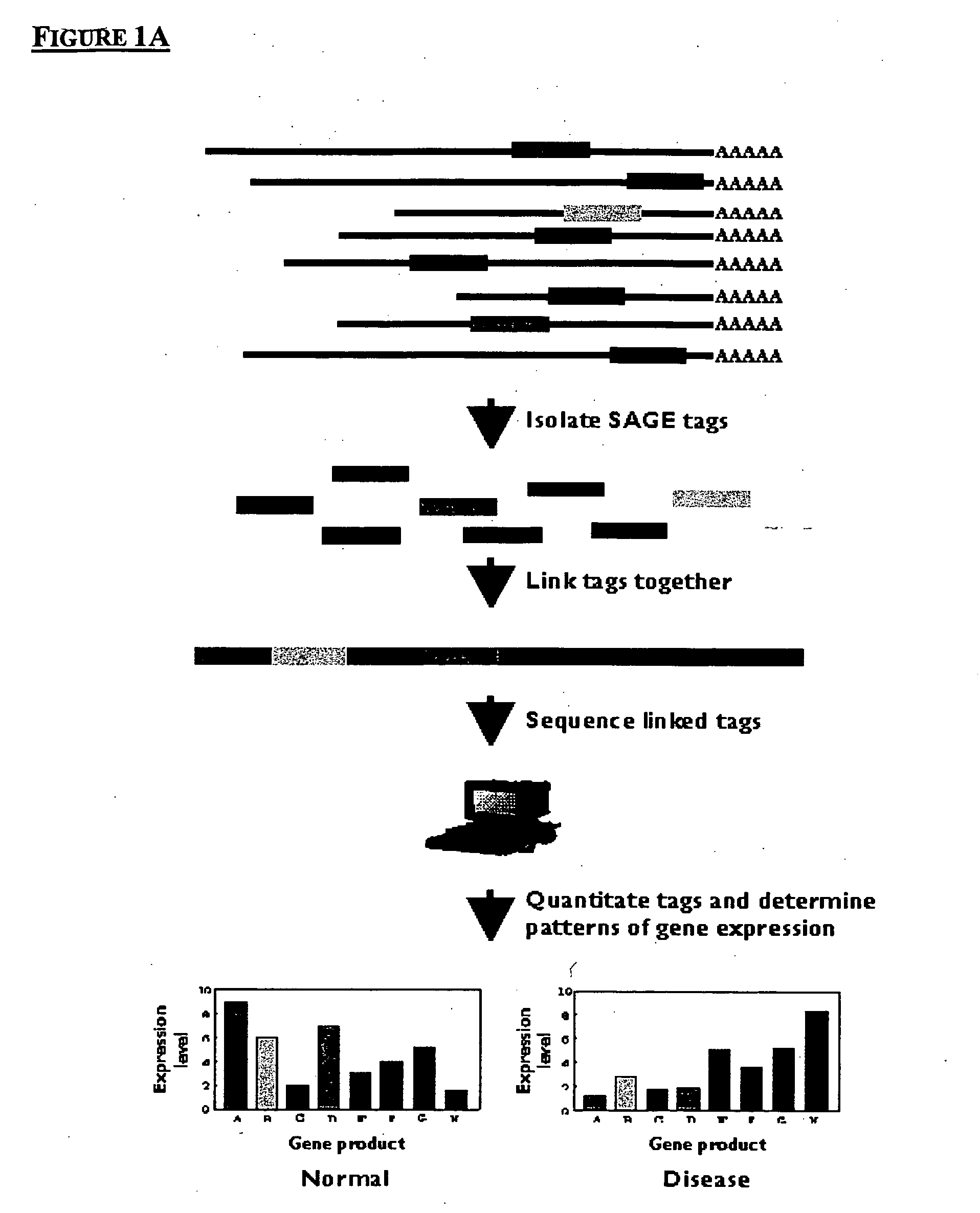Method to generate or determine nucleic acid tags corresponding to the terminal ends of DNA molecules using sequences analysis of gene expression (terminal SAGE)
- Summary
- Abstract
- Description
- Claims
- Application Information
AI Technical Summary
Benefits of technology
Problems solved by technology
Method used
Image
Examples
example 1
5′ Terminal SAGE Operational Protocol
[0260] 1.1 Full Length cDNA Synthesis
[0261] NotI-oligo dT primers (14 μg) and 20 μg of polyA+ RNA are ethanol precipitated and resuspended into 10 μl of ddH2O. Heat up at 65° C. for 10 min and left at 42° C. for 1 min.
[0262] In a separate tube, mix the following components: 5× first strand synthesis buffer 30 μl, 0.1M DTT 11 μl, 10 mM dNTP 9 μl, saturated trehalose 15 μl, 4.9M sorbitol 50 μl and Superscript II reverse transcriptase 15 μl. Mix with RNA from above and incubate at 40° C. for 4 min, 50° C. for 2 min and 56° C. for 60 min. 2 μl of proteinase K (20 mg / ml) is added and the reaction is incubated at 45° C. for 15 min followed by phenol / chloroform extraction and ethanol precipitation.
[0263] The RNA / cDNA heter-duplex is resuspended into 44.5 μl of ddH2O. 3 μl of 1.1 M NaOAc pH 4.5 and 2.5 μl of 100 mM NaIO4 are added to oxidize the diol structures of the mRNA. The 50 μl reaction is incubated on ice in the dark for 45 min followed by add...
example 2
Ligating Tags to Create Ditags
[0286] Resuspend the precipitated pellet from the above in 1.5 μl and add 1.5 μl of the following reagents to form the ditags.
3 mM Tris-HCl, pH 7.51.25 μl10X Ligation buffer0.75 μlddH200.75 μlT4 ligase 1 μl
[0287] Incubate at 16° C. for overnight.
[0288] 2.1 PCR Amplifying and Gel Purifying the 138 bp Ditags
[0289] Set up 200 to 300 reactions as following (in 96 PCR plates).
10XBV buffer 5 μlDMSO 3 μldNTPmix7.5 μlPCR primer A (175 ng / μl) 2 μlPCR primer B (175 ng / μl) 2 μlddH20 29 μlPlatinum Taq enzyme0.5 μlTemplate (1:230 dilution) 1 μlTotal volume 50 μl
[0290] Cycling condition: 95° C. 2′ 1 cycle. 95° C. 30″, 55° C. 1′, 70° C. 1′. 27 cycles. 70° C. 5′.
[0291] Run a diagnostic 4% agarose gel to analyze the PCR product and purify the 138 bp ditags by 12% polyacrylamide gel electrophoresis.
[0292]2.2 Digesting the Ditags with Anchoring Enzyme BseRI and Purifying the 46 Bp Ditag
[0293] Digest the 138 bp ditags with BseRI to yield 46 bp ditag.
138 b...
example 3
3′ Terminal SAGE Operational Protocol
[0300] 3.1 cDNA Synthesis
[0301] GsuI-dT16 primers (1 μg) and 5 μg of polyA+ RNA are mixed in final volume of 7 μl. Heat up at 70° C. for 10 min and leave on ice.
[0302] Synthesize the cDNA according to the manufacturer's recommendation (Invitrogen superscript cDNA synthesis system) but using the Biotinylated SalI adaptor. The excess adaptor is removed by Sephacryl-300.
[0303] 3.2 Binding cDNA to Magnetic Beads
[0304] Dynabeads M280 streptoavidin beads are used to bind the Biotinylated cDNA fragments according to the manufacturer's recommendation.
[0305] 3.3 Digesting the cDNA with GsuI to Remove PolyA Tail
[0306] The double strand cDNA on beads are digested with GsuI at 30° C. for 1 hour. After the digestion is completed, inactivating the enzyme by washing the tube twice with buffer containing 1% SDS. Four more wash with wash buffer (5 mM Tris-HCl pH 7.5, 0.5 mM EDTA. 1 mM NaCl and 200 μg / μl BSA). The last wash use 1× ligation buffer.
[0307] 3....
PUM
| Property | Measurement | Unit |
|---|---|---|
| Temperature | aaaaa | aaaaa |
| Temperature | aaaaa | aaaaa |
| Volume | aaaaa | aaaaa |
Abstract
Description
Claims
Application Information
 Login to View More
Login to View More - R&D
- Intellectual Property
- Life Sciences
- Materials
- Tech Scout
- Unparalleled Data Quality
- Higher Quality Content
- 60% Fewer Hallucinations
Browse by: Latest US Patents, China's latest patents, Technical Efficacy Thesaurus, Application Domain, Technology Topic, Popular Technical Reports.
© 2025 PatSnap. All rights reserved.Legal|Privacy policy|Modern Slavery Act Transparency Statement|Sitemap|About US| Contact US: help@patsnap.com



